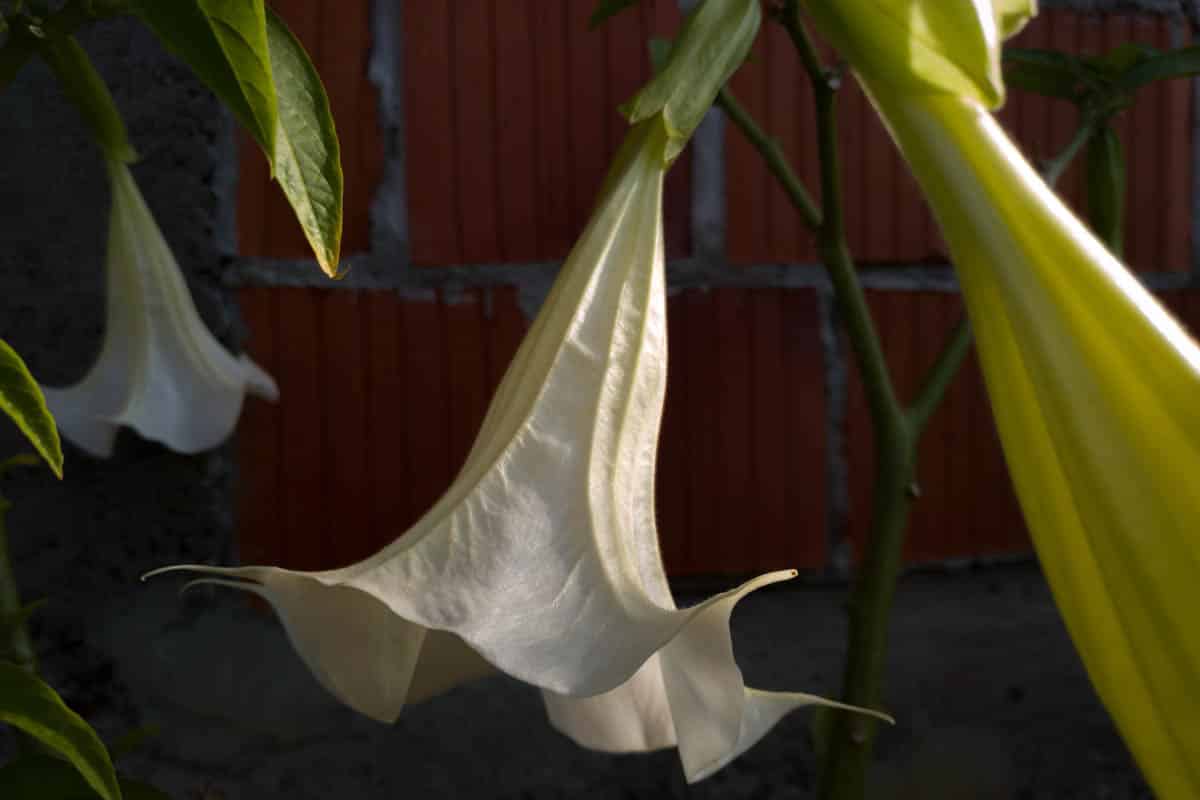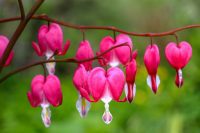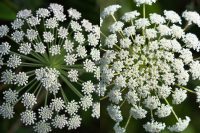Plants have devised a number of ways to protect themselves from herbivory. Thorns, bark, and toxins all serve to deter insects and animals. Toxins can be mild and self-limiting or deadly. We take a look at ten of the world’s most toxic plants.
Aconitum napellus

| Family | Ranunculaceae |
| Botanical name | Aconitum napellus |
| Common names | Monkshood, aconite monkshood, wolfsbane, mousebane, women’s bane, devil’s helmet, queen of poisons, blue rocket, friar’s cap |
| Plant type | Herbaceous, perennial |
| Flower colour | Blue, purple, white, yellow, pink |
| Native to | Europe and Asia |
| Toxic property | Aconitine |
Monkshood is a genus of perennial herbs native to Europe and North America that is grown as an ornamental plant in the garden. There are a number of toxic alkaloids (nitrogen-containing compounds), but aconitine is the principal toxin.
Aconitine (known as the ‘queen of poisons’), opens voltage-dependent sodium channels that pump sodium ions in and out of the muscles and neurons resulting in muscles (including the heart) and neurons that are unable to be repolarised. This leads to arrhythmias (irregular heartbeat), muscle spasms, respiratory paralysis and gastrointestinal disturbances (vomiting, diarrhea). The onset of symptoms is minutes to hours after exposure.
All parts of Aconitum napellus are poisonous, but the highest concentration is found in the roots and seeds.
Ricinus communis
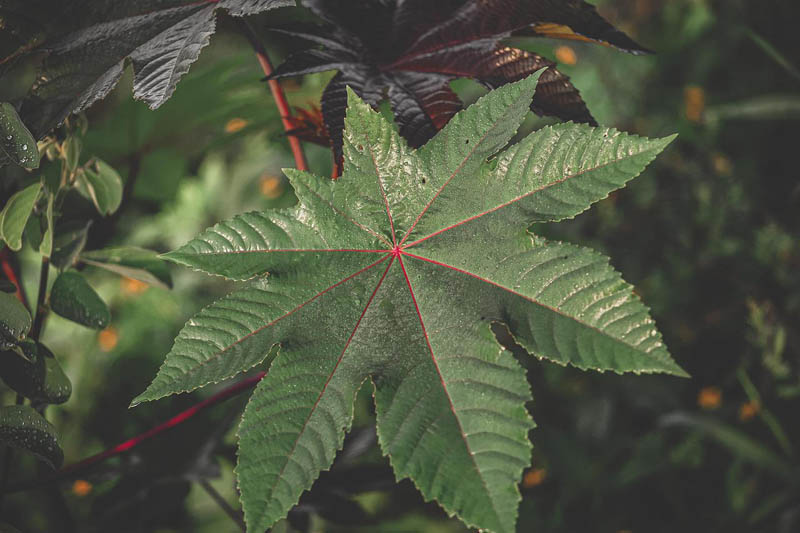
| Family | Euphorbiaceae |
| Botanical name | Ricinus communis |
| Common names | Castor oil plant, Mole bean plant, African wonder tree, Castor bean, Maple weed, Palm of Christ |
| Plant type | Herbaceous, perennial |
| Flower colour | Yellow |
| Native to | Middle east and Africa |
| Toxic property | Ricin |
Castor oil plant is a herbaceous perennial native to the Middle East and Africa. Its large palmate leaves provide an eye-catching display as a houseplant or in the garden. India produces 75% of the world’s castor oil, which is a natural laxative. Castor oil is produced by pressing the ripe seeds that have had their hull removed. Ricin is inactivated by heating during the oil extraction process.
The toxic principle is ricin, which inhibits ribosomal protein synthesis, leading to cellular death as well as acute liver and kidney failure. All parts of R. communis are toxic, however, the highest concentration is in the seeds.
Digitalis purpurea
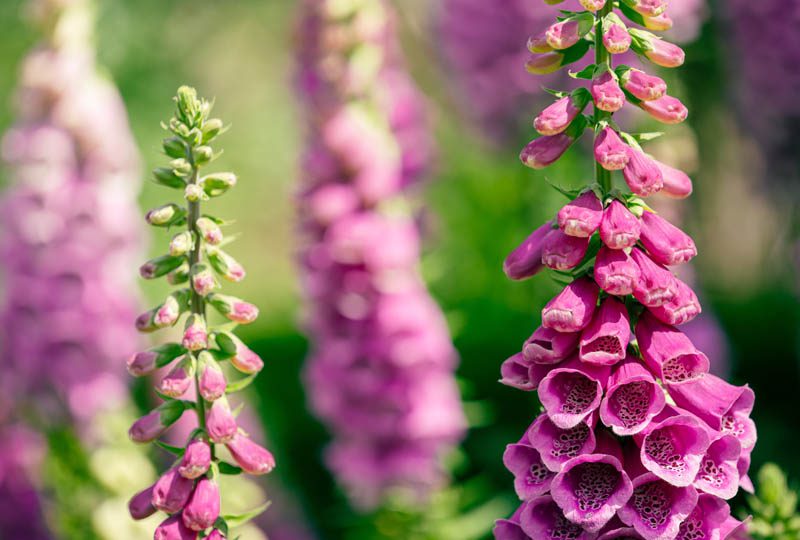
| Family | Scrophulariaceae |
| Botanical name | Digitalis purpurea |
| Common names | Foxglove, Lady’s glove, Fairy’s glove, Virgin’s glove, Witch’s gloves, Dead man’s bells |
| Plant type | Biennial |
| Flower colour | Pink, purple, red, white, yellow |
| Native to | Europe, western Asia, and northwestern Africa |
| Toxic property | Cardiac glycosides, including digoxin and digitoxin |
Foxglove is a herbaceous biennial native to Europe, western Asia, and northwestern Africa. The attractive tubular pendant flowers that grow in pink, purple, yellow and white are popular in cottage gardens.
Foxgloves contain cardiac glycosides, including digoxin and digitoxin which cause cardiac arrhythmias, vomiting, diarrhea, heart failure and death. All parts of foxglove are toxic.
Ageratina altissima
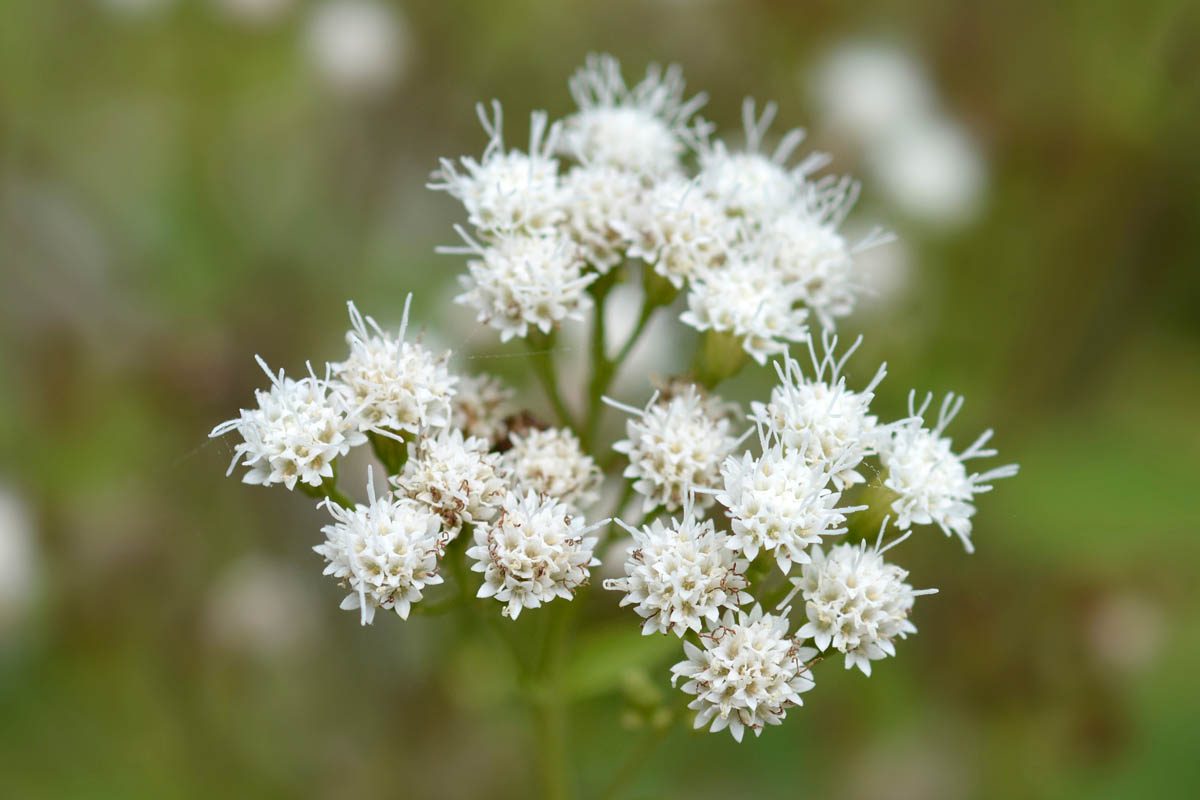
| Family | Asteraceae |
| Botanical name | Ageratina altissima |
| Common names | White snakeroot, Richweed, Tall boneset, White sanicle |
| Plant type | Herbaceous perennial |
| Flower colour | White |
| Native to | Eastern and central North America |
| Toxic property | Trematol |
White snakeroot is a herbaceous perennial native to deciduous woodland areas of eastern and central North America and is grown in borders, cottage, wildlife and woodland gardens.
The toxic properties of white snakeroot is trematol. When a cow consumes snakeroot, the toxin contaminates the milk which causes milk sickness in humans and trembles in livestock. Consumption of contaminated beef can also cause milk sickness. Early European settlers who grazed their cattle in areas with white snakeroot began to fall ill and die. It can take one to three weeks of eating white snakeroot for symptoms to develop in livestock. Affected animals develop degeneration of the skeletal muscles. Clinical signs include violent trembling, depression, salivation, difficulty breathing, exercise intolerance, stumbling, and depression.
Symptoms of milk sickness in humans include weakness, muscle stiffness, vomiting, abdominal pain, bad breath, listlessness and coma. Milk sickness killed Nancy Hanks Lincoln in 1818, Abraham Lincoln’s mother.
Nerium oleander
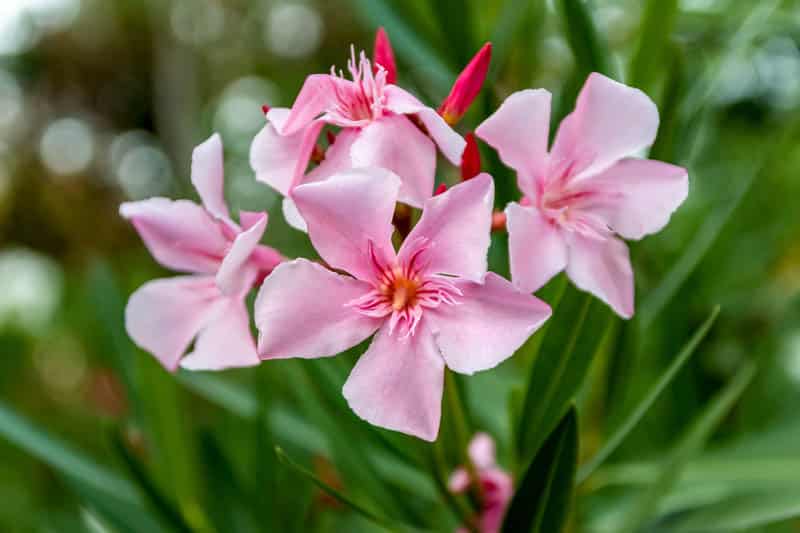
| Family | Apocynaceae |
| Botanical name | Nerium oleander |
| Common names | Oleander, Common oleander, Rose bay, Kaner, Soland |
| Plant type | Broadleaf evergreen |
| Flower colour | White, pink, red, yellow, orange, cream and purple |
| Native to | Southern Asia and the Mediterranean |
| Toxic property | Cardiac glycosides (cardenolides) – Oleandrin and neriine |
Oleander is an ornamental shrub native to Southern Asia and the Mediterranean that is widely grown in warm climates for its long-lived trumpet-shaped flowers which bloom from early summer until autumn.
The toxic principles are oleandrin and neriine, which are cardiac glycosides and plant steroids derived from the linear triterpene squalene. Cardiac glycosides inhibit the sodium/potassium ATPase pump which maintains osmotic equilibrium and membrane potential in cells. This causes electrolyte derangements, (elevated potassium and elevated calcium) resulting in life-threatening cardiac arrhythmias or rhythm disturbances.
Cicuta douglasii
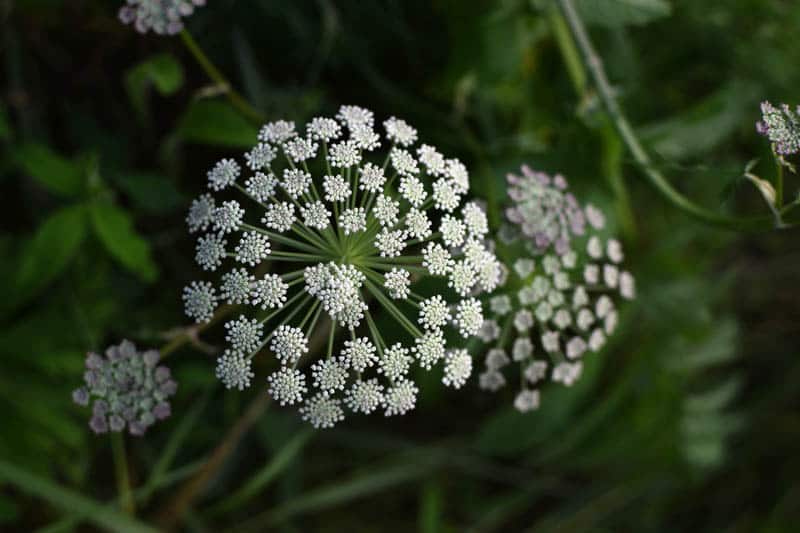
| Family | Apiaceae |
| Botanical name | Cicuta douglasii |
| Common names | Water hemlock, Western water hemlock |
| Plant type | Herbaceous perennial |
| Flower colour | White |
| Native to | North America |
| Toxic property | Cicutoxin |
Water hemlock is a flowering perennial plant native to North America. Their habitat is wet seepage areas and can reach a height of 1 metre. Water hemlocks are members of the carrot family. Unlike their edible relatives, water hemlock is considered one of the most toxic plants on earth.
The toxic principle is cicutoxin, a highly unsaturated alcohol that disrupts the nervous system. All parts of water hemlock are toxic, however, the tuberous roots contain the highest level of toxins. Cicutoxin acts as a central nervous system stimulant, by binding the GABA receptor, resulting in its deactivation. GABA receptors receive chemical messages that inhibit or reduce nerve impulses when deactivated, cause cellular hyperactivity resulting in seizures.
Clinical signs of water hemlock toxicity develop between 30 minutes to several hours after exposure and include agitation, nervousness, twitching, seizures, difficulty breathing and death.
Abrus precatorius
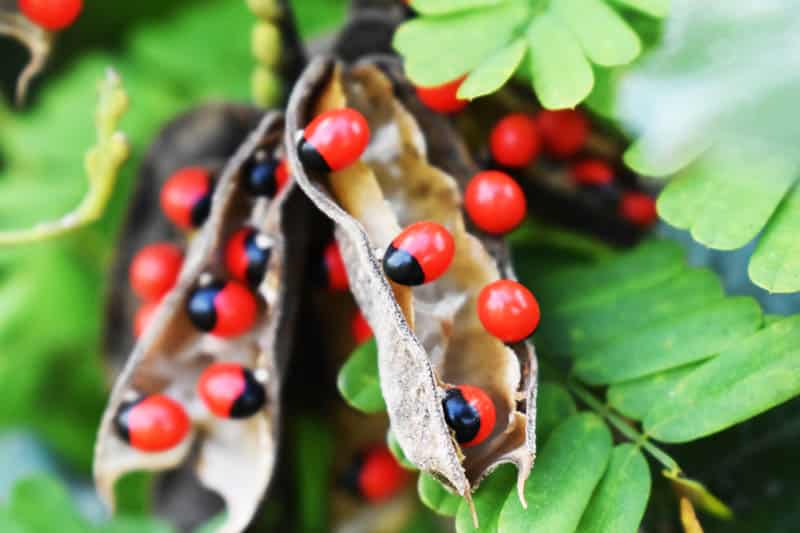
| Family | Fabaceae – legume |
| Botanical name | Abrus precatorius |
| Common names | Rosary pea, Prayer bean, Paternoster pea, Love pea, Precatory pea, John Crow beard, Red-bead vine, Jumbie bead, Weather plant, Crab’s eye, Coral bead, Indian liquorice, Jequirity bean |
| Plant type | Perennial vine |
| Flower colour | Pink, purple, white |
| Native to | Australia and Asia |
| Toxic property | Abrin |
Rosary pea is a perennial vine native to Australia and Asia. The highly toxic distinctive red peas were used to make jewellery, rosaries and musical instruments.
The toxic principle is abrin, a lectin. Lectins are proteins found in plants that bind to specific carbohydrates and play vital roles including protecting plants against pathogens. Abrinconsists of an A-chain and a B-chain, linked by a disulphide bond. The B-chain binds to the surface of a cell, enabling the entire molecule to enter. An enzyme breaks the disulphide bond and separates it into two chains. The A-chain inactivates the ribosomes of the cells, which produce all its protein, leading to cell death. The hard outer coating of the highly toxic seed reduces the risk of toxicosis, however, when this shell is broken, the toxin is released.
Clinical signs develop within 8 hours to 3 days after exposure and include abdominal pain, vomiting, nausea, bloody diarrhea, elevated heart rate, irregular heartbeat, hallucinations, seizures and organ failure.
Atropa belladonna
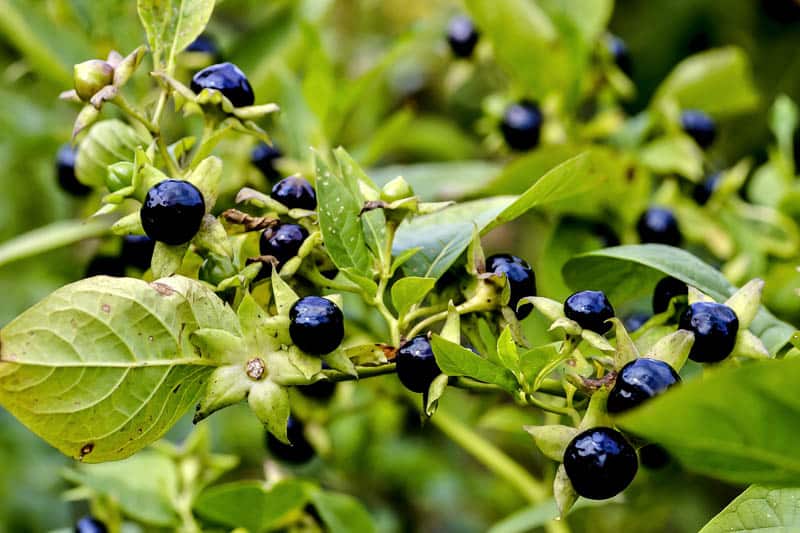
| Family | Solanaceae – Nightshade |
| Botanical name | Atropa belladonna |
| Common names | Deadly nightshade, Belladonna, Dwale, Naughty man’s cherries, Divale, Banewort, Devil’s berries, Death cherries, Beautiful death |
| Plant type | Perennial herb/shrub |
| Flower colour | Pink, purple, brown |
| Native to | Europe, North Africa, Western Asia |
| Toxic property | Tropane alkaloids (atropine, hyoscyamine and copolamine) |
Deadly nightshade is a herbaceous perennial native to Europe, North Africa and Western Asia. Atropa is named after Atropos, the Greek fate who cut the thread of life. Belladonna means ‘beautiful lady‘ in Italian and refers to the use of deadly nightshade to dilite the pupils to appear more attractive. Deadly nightshade produces bell-shaped flowers in summer followed by attractive black fruit which is easily mistaken for edible fruits.
The toxic principle is tropane alkaloids which are found in all parts of the plant, however, the roots contain the highest concentrations. Tropane alkaloids have anticholinergic effects (especially antimuscarinic), block the action of acetylcholine, a neurotransmitter of the parasympathetic nervous system responsible for the contraction of smooth muscles, dilation of blood vessels, increase in bodily secretions, and slowing the heart rate.
Clinical signs develop between 30 – 60 minutes of exposure and include rapid pulse, elevated blood pressure, hallucinations, fever, tremors, dry mouth, dilated pupils, flushed skin, urinary retention and inhibition of sweating.
Brugmansia spp.
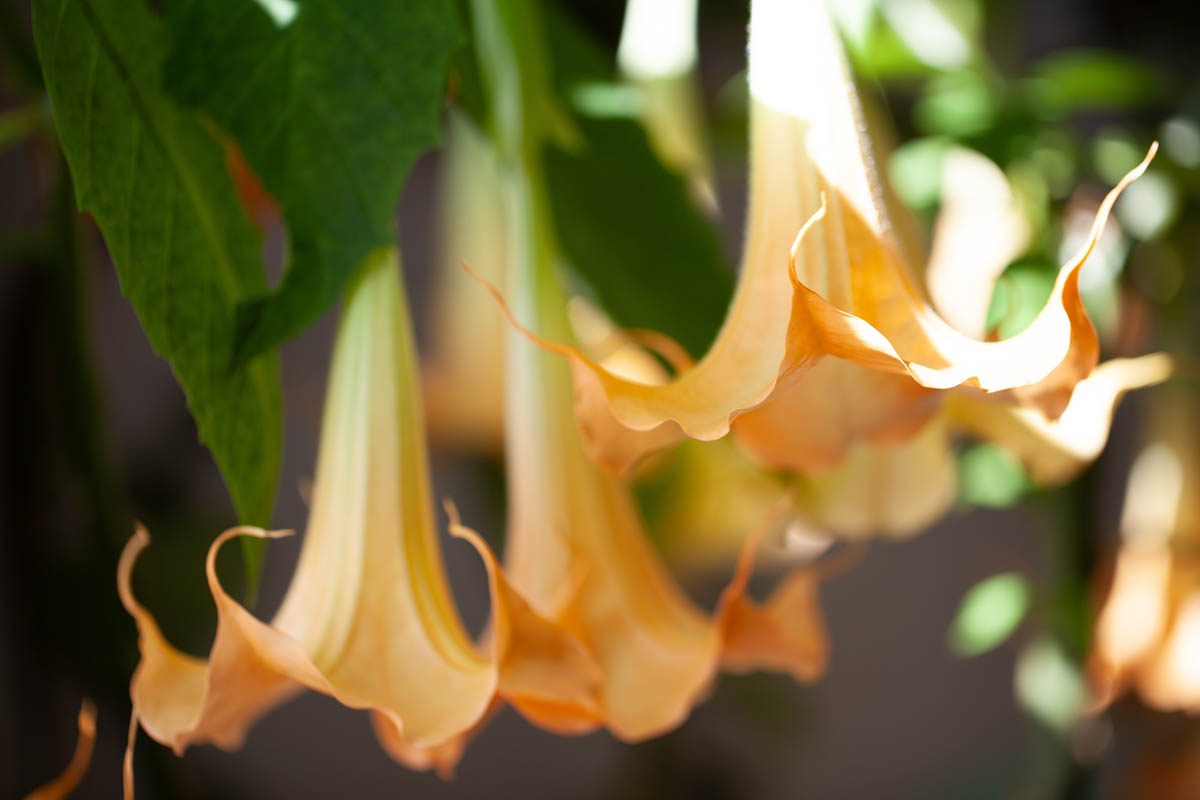
| Family | Solanaceae |
| Botanical name | Brugmansia spp. |
| Common names | Angel’s trumpets, Angel’s tears, Night bells |
| Plant type | Perennial, shrub |
| Flower colour | White, yellow, apricot |
| Native to | South America |
| Toxic property | Tropane alkaloids (atropine and scopolamine) |
Angel’s trumpet is a genus of 7-8 species of large flowering shrubs native to South America and grown as an ornamental plant for its large, showy, pendulous scented flowers.
The toxic properties of angel’s trumpet are tropane alkaloids (atropine and scopolamine), which have an anticholinergic effect. Anticholinergics block the action of acetylcholine, the chief neurotransmitter of the parasympathetic system that dilates blood vessels, contracts smooth muscles, and slows the heart rate. Scopolamine is also known as ‘devil’s breath‘ as it was used by robbers in Columbia to incapacitate its victims. All parts of angel’s trumpet are poisonous, however, the highest concentrations of tropane alkaloids are in the leaves and seeds.
Clinical signs of angel’s trumpet toxicity include dilated pupils (mydriasis), blurred vision, increased heart rate (tachycardia), urinary retention, hallucinations, agitation, seizures, agitation, coma, lack of normal intestinal contractions (ileus), and elevated body temperature (hyperthermia).
Hippomane mancinella
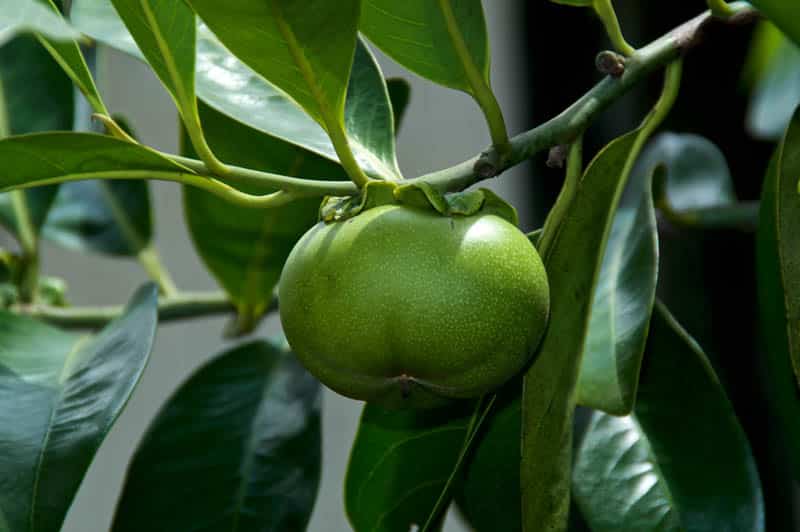
| Family | Euphorbiaceae |
| Botanical name | Hippomane mancinella |
| Common names | Manchineel, Tree of death, Poison guava, La Manzanilla de la Muerte, Beach apple |
| Plant type | Flowering tree |
| Flower colour | Green/yellow |
| Native to | Southern North America to northern South America |
| Toxic property | Hippomanin A and B |
The manchineel tree is a flowering tree native to southern North American and northern South America and is considered the most toxic tree on earth and is rumoured to have killed explorer Juan Ponce de Leon. It is found in mangroves along the edge of beaches in the Caribbean Islands. The manchineel tree is so dangerous that even standing beneath it when it’s raining is enough to cause poisoning and warning signs are commonly placed around these trees.
All parts of the manchineel tree are toxic, the milky sap oozes out of leaves, twigs, bark and fruit and causes burn-like blisters when it comes into contact with the skin or mucous membranes. Even burning the tree produces toxic smoke which can burn the skin, lungs and eyes. The toxic properties include hippomanin A and B as well as unidentified toxins.
Clinical signs depend on the mode of exposure but include painful blisters, swelling of the throat, temporary blindness, abdominal pain, vomiting, diarrhea and death.
Julia is a writer and landscape consultant from Wollongong with a love of horticulture. She had been an avid gardener for over 30 years, collects rare variegated plants and is a home orchardist. Julia is passionate about learning and sharing her knowledge of plant propagation and plant toxicology. Whether it’s giving advice on landscape projects or sharing tips on growing, Julia enjoys helping people make their gardens flourish.
